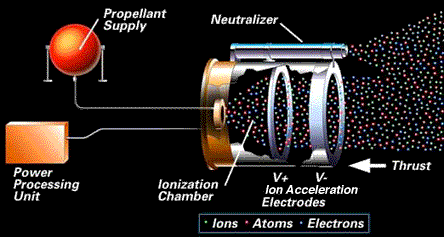
Ion
Propulsion

Figure 11
Ion propulsion uses ionized fuel as a means of propulsion. Figure 11 shows the basic schematic of an ion engine. A fuel, usually xenon, is passed through a cathode, which ionizes the gas (removes the electrons), the excess electrons are sent to an anode, which the gas is not attracted to. The ionized gas is then passed through a voltage gradient that accelerates it to a high speed. Then a neutralizer emits electrons back into the gas stream as it leaves in order to make the gas inert again. This prevents the gas from being sucked back into the engine by the voltage gradient. Specific impulses vary depending on engine design and how much voltage is being used, but it could be possible to create specific impulses as high as 20,000 seconds if a large enough power plant is used.
The first ion engine was successfully tested on Deep Space 1 and is now currently being tested to see if it can be scaled up for larger interplanetary missions. The drawback to using an ion engine is that it takes a long time to speed the craft up. The advantage though is that very little fuel is used to produce thrust, therefore the fuel can be used for a very long time. This will allow the craft to eventually reach extremely high speeds. NASA sees this as an optimum means of transportation to the outer system, or Jupiter and beyond, and is probably the best means to reach planets beyond our solar system.
Other Related Sites: